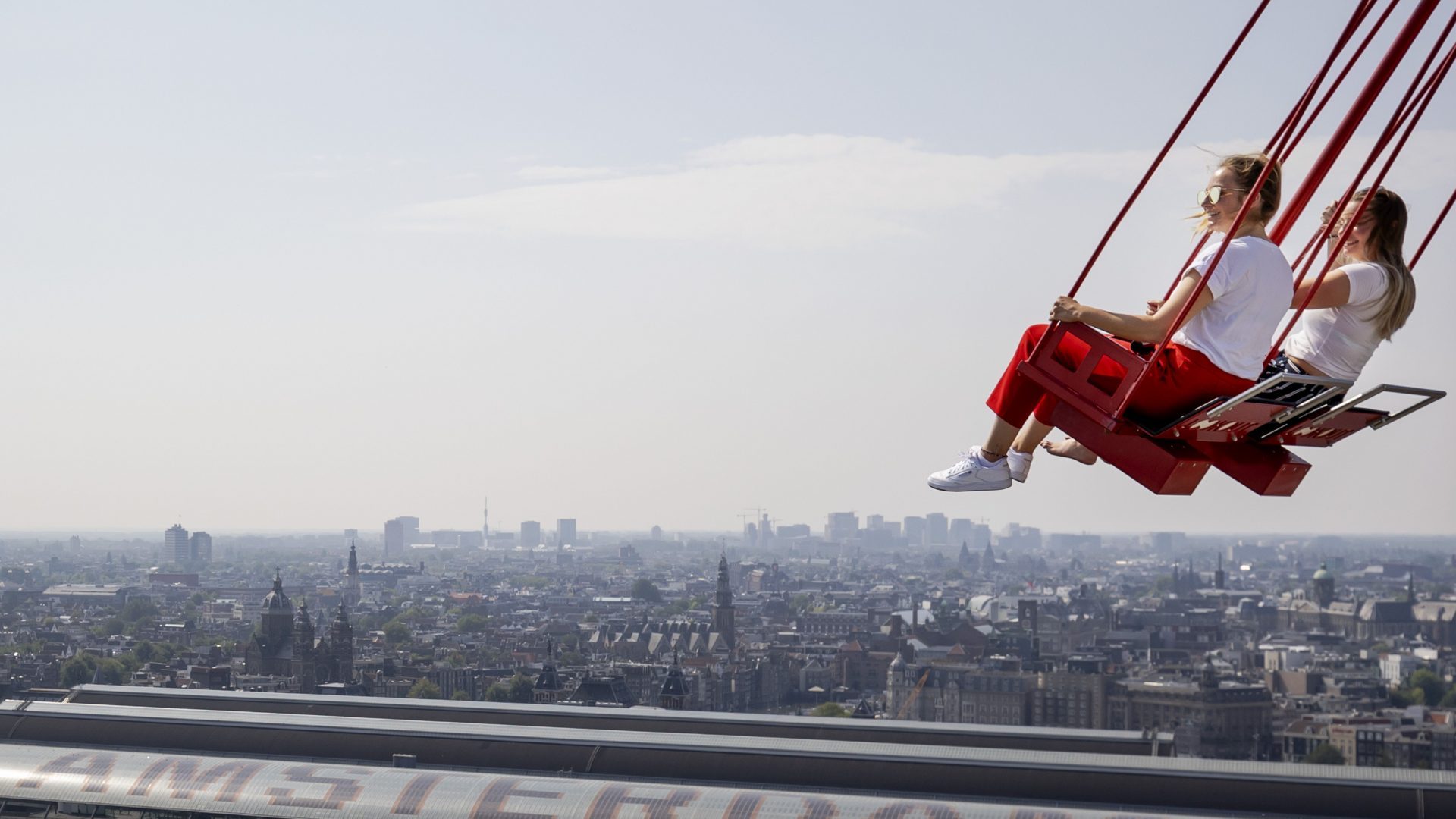Once in part a gallows field where until the late 18th century the bodies of executed criminals swung as a warning to others, Amsterdam’s northern borough, Noord, is changing and gentrifying at a dizzying pace. Now visitors dangle over the edge of the 100-metre-tall A’dam Tower on the northern shore of the IJ, Amsterdam’s waterfront, in a tourist attraction billed “the highest swing in Europe”, and the gallows have been replaced by a forest of construction cranes.
Separated from the rest of the city by the water of the IJ, Noord is predicted to have the fastest relative population growth among all Amsterdam’s inner boroughs over the next 10 years, with 40% more homes by 2050. Amsterdam’s population these days is inching towards one million and it badly needs room to grow; Noord’s old industrial areas and green spaces offer more than most other parts of this compact city.
As in many other redeveloped urban areas around the world, culture and nightlife paved the way for developers. The once unfashionable “other side of the IJ” – somewhat akin to Manhattanites’ disdain for the “Bridge and Tunnel crowd” – has become a magnet for tourists. Even many of the once dismissive residents of other parts of Amsterdam now stoically endure the three- to five-minute trip on the ferries behind Central Station.
But both the nightlife and the new residents sometimes bump into an older population that is generally less wealthy and often values the vaunted “special character” of the borough.
Many of the changes date back just a decade, when the eye-catching Eye film museum opened on the IJ shore across from Central Station, on the former terrain of Royal Dutch Shell, the oil company. The A’dam tower in the old Shell HQ opened in 2016 with a revolving restaurant on the top floor and an observation deck on the roof hosting the aforementioned swings. And the old Shell canteen became a restaurant and cultural hub, the Tolhuistuin, opening in 2013 after an eight-year-long renovation.
Chris Keulemans, who founded it admits ruefully: “I was, in hindsight, the first new Northerner, the vanguard of gentrification. I had no idea at the time but that has become very clear.”
Keulemans moved to Noord when he was developing the Tolhuistuin. “Now, 15 years later, I’m part of two local action groups that are worried about the steamroller of gentrification and the way it comes at the expense of the people, neighbourhoods, green spaces and the culture that was here.”
Social housing and relatively affordable prices brought many migrants to Noord in the second half of the 20th century, complementing a large working-class and relatively poor population. Many of them now fear being pushed aside.
Massih Hutak, artist, rapper and founder of the residents’ movement Defend Noord, has a weekly column in Amsterdam’s daily newspaper, Het Parool. In July he wrote: “While we as residents create ever stronger communities and fight for an undivided neighbourhood, the municipality works in parallel – ostensibly with the same ambition – still within a system that in the end will make our existence in the city impossible.”
Similar warnings are sounded by some local politicians. Canan Uyar, a four-term Labour representative on Noord’s local council, has seen some old neighbourhoods of Noord being wilfully neglected both by housing corporations that want to demolish and redevelop them, and by the city. “Something is going wrong in Noord,” she warns. “Residents say, we want attention for our problems, we want our rights. We’re entitled to the same beautiful public spaces and houses as the newcomers. Why should we live in a draughty, mouldy house?”
Definitely not draughty nor mouldy is the home of Paul Keller, a researcher at the University of Amsterdam, and Sara Kolster, a graphic designer. They and their two children moved into their sprawling apartment in a gleaming gold-coloured monolith in the new Buiksloterham development in Noord in May and are over the moon. They came from an older, smaller apartment in the western part of the city.
“The 1920-30 houses were very characteristic, one of the reasons to live in a city like Amsterdam,” says Kolster. “Lots of expats are happy to pay for those places, but in terms of comfort and square metres we are better off here.” Keller is philosophical about the changes that the presence of newcomers such as himself bring to the area. “A hundred years ago, this was agrarian countryside. Fifty years ago, there was heavy industry, enormously polluting, a chemical works where explosions occurred regularly. And now it’s a well-thought-out, hopefully environmentally circular, neighbourhood.”
Change is indeed a constant in Noord, more so than in older, more historical parts of town. Rick Nelson came to the Hamerkwartier area of Noord in 2015 as one of the founders of Oedipus, a microbrewery. “We were really the first ones there; the only other place was some distance away. The first year it was very quiet, only a few people passed by,” he recalls. Now there are dozens of entertainment and nightlife spots in the quarter.
Nelson now runs Taverno, a restaurant and bar with a large outdoor terrace in a nearby part of Noord where he says both old and new Northerners can mix. But change is lurking around the corner; the municipality only leases the location short term and can close the terrace with four months’ notice. “The city is planning to use this location once a developer has bought up all the remaining plots in this street,” he explains.
The pace of change is so fast that even those who make their work out of such things can find it daunting. Zachary Formwalt, an artist and film-maker from the US, moved to Amsterdam Noord in 2011. His art often focuses on urban renewal. But he’s never done a project in his own, rapidly changing part of Amsterdam. “There’s just too much happening here,” he says. “If I did a project on Noord, it would be very hard to separate work from life and leisure, because I’m right in the middle of it.”
Ferry Biedermann is a journalist based in Amsterdam



